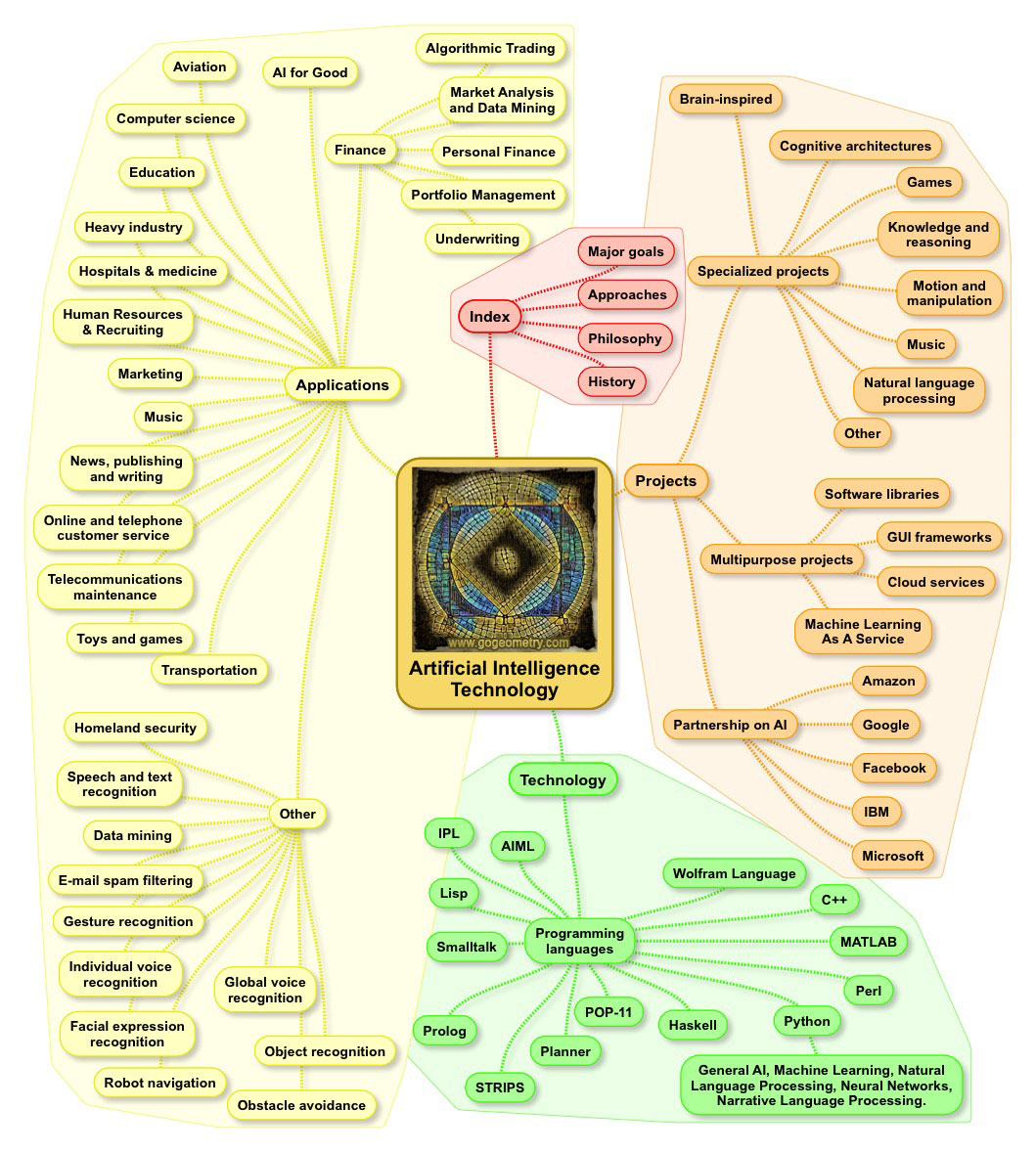Artificial Intelligence (AI): Technology Mind Map

Artificial Intelligence
Artificial Intelligence is a branch of computer science dealing with the simulation of intelligent behavior in computers. The goals of AI research include reasoning, knowledge, planning, learning, natural language processing, perception,
decision making, and the ability to move and manipulate objects.
AI (Artificial Intelligence) technology refers to the development of computer systems that can perform tasks that would typically require human intelligence, such as perception, reasoning, learning, decision-making, and natural language processing.
AI technology encompasses a range of techniques, including machine learning, deep learning, natural language processing, computer vision, robotics, and expert systems.
Machine learning algorithms use statistical models to learn from data and improve their performance over time. Deep learning, a subfield of machine learning, uses artificial neural networks to simulate the human brain and recognize patterns in data.
Natural language processing involves teaching machines to understand and process human language, while computer vision enables machines to recognize and interpret visual information. Robotics involves the development of intelligent machines that can perceive and interact with the physical world.
AI technology has a wide range of applications, including in fields such as healthcare, finance, education, transportation, and entertainment. Some examples of AI-powered systems include virtual assistants like Siri and Alexa, image recognition systems used in self-driving cars, and fraud detection systems used by banks.
The technology of AI (Artificial Intelligence) includes a wide range of applications, projects, and programming languages.
Applications:
AI technology has numerous applications in various fields, including but not limited to:
Healthcare: AI can be used to diagnose diseases, develop personalized treatment plans, and analyze medical images.
Finance: AI can be used to detect fraud, make investment decisions, and optimize trading strategies.
Education: AI can be used to develop personalized learning plans, identify learning gaps, and provide feedback to students.
Transportation: AI can be used in self-driving cars to detect obstacles and navigate roads.
Entertainment: AI can be used to develop video games, virtual reality experiences, and personalized recommendations for TV shows and movies.
Projects:
AI technology has also led to several notable projects, including:
AlphaGo: A deep learning-based computer program developed by Google that defeated the world champion in the game of Go.
Watson: An AI-powered system developed by IBM that can answer natural language questions and has been used in fields such as healthcare and finance.
Sophia: An AI-powered humanoid robot developed by Hanson Robotics that can interact with people and respond to their questions.
Programming languages:
Finally, AI technology involves the use of various programming languages, including:
Python: A popular language for AI development due to its simplicity and flexibility.
Java: A widely used language for developing AI-based applications.
C++: A language commonly used for developing high-performance AI applications.
R: A language commonly used for statistical computing and data analysis in AI applications.
These are just a few examples of the applications, projects, and programming languages involved in AI technology, as the field continues to grow and evolve rapidly.
Mind map based on
Wikipedia: Artificial Intelligence and
Wikipedia: Outline of AI as of
October 15, 2017.
Graphic Organizers
Graphic organizers are visual tools used to represent information, concepts or ideas, while mind maps are a type of hierarchical diagram that organizes information visually, typically in a branching format, using keywords and images. Both graphic organizers and mind maps are useful for organizing and structuring ideas, facilitating learning and retention, and enhancing creativity and problem-solving skills.
Latest Topics in AI Technology
-
Exploring the Intersection of Academic Disciplines and Natural Language Processing.
GPT-3 and natural language generation - AutoML and democratization of machine learning
- AI-powered chatbots and virtual assistants
- Quantum computing and AI applications
- AI ethics and bias mitigation strategies
- Federated learning and privacy-preserving AI
- Explainable AI (XAI) and interpretability
- AI-powered healthcare solutions
- Generative adversarial networks (GANs) for creative applications
- AI-driven cyber security and threat detection
- Deep reinforcement learning for game AI
- Multi-modal machine learning for speech, text, and vision
- AI in finance and fraud detection
- Autonomous vehicles and AI-driven transportation
- AI-powered customer service and personalization
- AI-assisted drug discovery and development
- AI and predictive maintenance for manufacturing and industrial applications
- Edge computing and AI for low-latency applications
- Swarm intelligence and collective AI
- Human-centered AI and ethical design
- AI for social good and sustainable development
- AI for energy and climate change mitigation
- Natural language processing (NLP) for conversational AI
- Cognitive computing and AI for decision-making
- AI-powered supply chain optimization and logistics
Mind Map of NotebookLM, Google's AI Note-Taker.
Empowering Human Potential with ChatGPT and Bard's Mind Map
Artificial Intelligence Major Goals
Artificial Intelligence Approaches
Artificial Intelligence Technology
Artificial Intelligence Deep Learning



